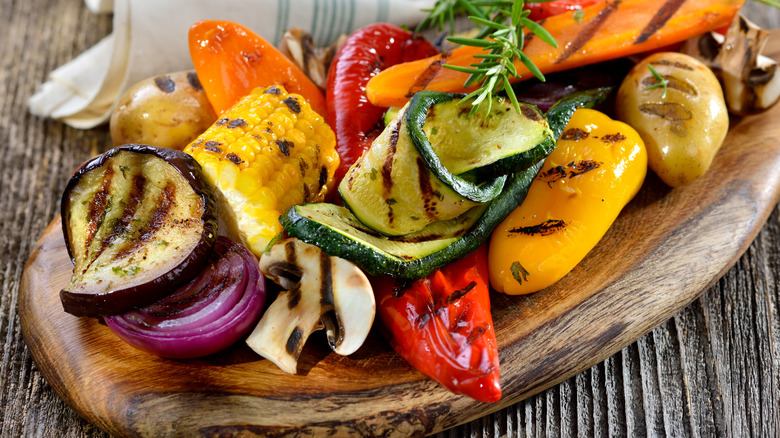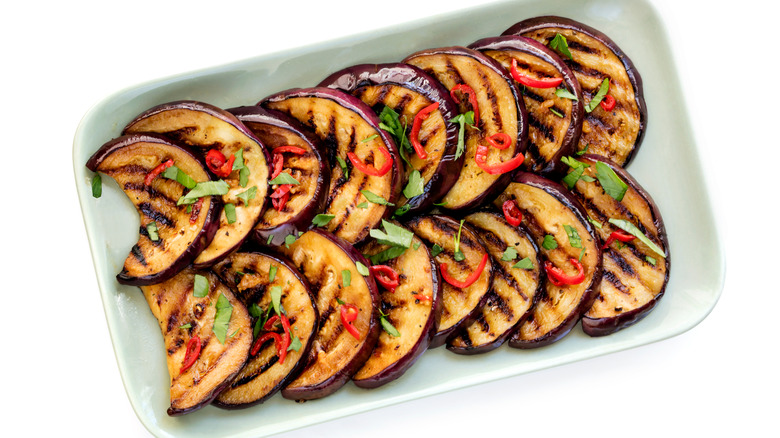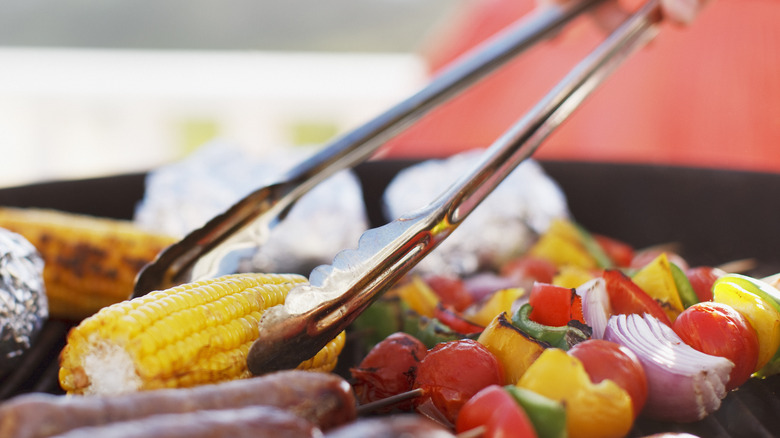The Unexpected Grilling Tip That'll Brown Your Summer Vegetables To Perfection
There's nothing quite like that smoky flavor of grilled food. Those grill marks impart a rustic heartiness to our fare, making it more savory and satisfying. Every diet style can find a favorite on the grill: marbled steak for the keto diet, lemon salmon for a Mediterranean twist, or even a vegan, gluten-free hot dog for the strictest eaters.
But vegetables are the most universally permissible food in all diets, and grilling takes their flavor to another level. A bland ol' mushroom can turn positively meaty under the influence of those hot grates. If you don't like a particular vegetable, try it grilled before you discount it altogether, and you may be surprised by the flavor transformation.
Like every culinary style, grilling has a few tried-and-true techniques to honor. Among the top tips for grilling vegetables, though, we're reconsidering one: salting before cooking. We've always said that salting your veggies before grilling can draw out moisture to concentrate flavor in the final product. However, it also creates a mushier texture, which many consumers don't like. You can retain a crisper texture by saving the salt until the end while enjoying that unbeatable grilled taste.
Get those grill marks before you season
Why is browning food desirable, anyway? Well, it comes down to the science behind that flavor transformation. It's not in your head; grilled food really does taste different (arguably better). The Maillard reaction is responsible for that golden hue your veggies take on after cooking — it's the reaction of sugar and protein with heat, which creates entirely new flavor compounds.
If you want enhanced flavor without the mush from water-logged produce, you can grill sliced, unseasoned veggies until tender. Then, remove them from the grill and season them immediately before they cool. By adding the salt after the cell walls are softened, your seasoning can penetrate the food deeper and create a richer flavor.
Removing the food from the grill before it chars is an important caveat. Because the grill can reach impressive temperatures of 500 F or more, the sugars and amino acids within the food can transform into a concerning substance called acrylamide in high heat. Studies on acrylamide's potential human harm are still pending, but many animal studies connect acrylamide with cancer. Therefore, you may want to err on the side of caution by limiting high-heat exposure to your food. However, if you've heard of heterocyclic amines (HCAs) linked with grilled food, you can rest assured the National Institute of Cancer determined that these nasty byproducts are typically found in grilled meats, not grilled vegetables.
The best vegetables to grill
So then, how do you choose among all the best grilling recipes for vegetables? Water content certainly comes into play in a big way. The higher the water content, the more the texture will change when that flaming hot grill begins to evaporate all the internal moisture. Among popular summer vegetables, yellow squash and bell peppers have the highest water content.
For the most stable texture on the grill, foods with lower water content are best. Options include corn on the cob, snow peas, par-cooked carrots, and greens. Also, when prepping your produce, be sure to use a generous cut. One of the most common mistakes when grilling vegetables is slicing them too thinly, which usually results in a burnt mess on the bars. That is if they don't fall between the grates first.
Ultimately, your decision to season your sides pre- vs. post-grill marks depends on the final texture you want. If you're craving some al dente zucchini, hold the salt until the end. If you want a soft but more intensely flavored pepper, go ahead and pre-season away.


